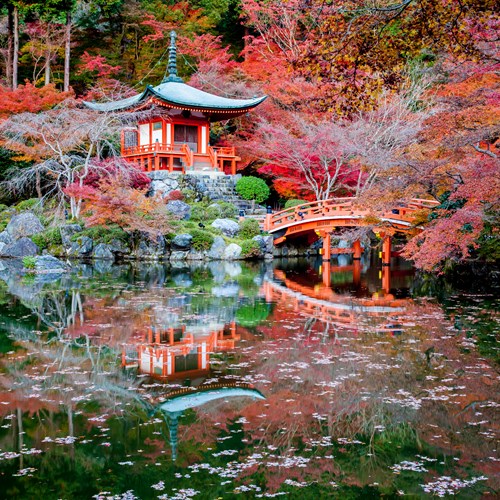
Kyoto, Japan
Steeped in history, the once-capital of Japan and the former seat of the Imperial House, Kyoto is famed for being home to endless Buddhist temples, Shintō shrines, Zen gardens and palaces, many of which are UNESCO World Heritage Sites. Aside from the magnificent architecture and fascinating history, the Kyoto of today is a youthful and vibrant city that stays close to its spiritual and historical roots.
Population:
1.475 million (2015)
Currency:
Yen (¥) 1/100
Banknotes: ¥1000, ¥5000, ¥10,000
Coins: ¥1, ¥5, ¥10, ¥50, ¥100, ¥500
Emergency Numbers:
Direct-dial emergency number: 119
Police: 110
Opening Hours:
Department stores and large shops operate 7 days a week, from 10am to 8pm. Independent shops are open from 9am to 5/6pm (this may vary by shop). Snacks, drinks and coffees to-go can be purchased at 24/7 convenience stores. Banks operate from 9am to 3pm, Monday to Friday.
Note that not all ATMs operate 24 hours in Japan.
Most tourist attractions, such as temples and shrines, are open from 9am to 5pm.
Newspapers:
Kyōto Shimbun
The Asahi Shimbun
The Japan Times
The Mainichi Shimbun
The City

Nestled among the mountains of Western Honshu, Heian-kyō (which translates to "capital of peace and tranquillity"), the former name of Kyōto, was the capital of Japan and the seat of the imperial court from 794 until the Meiji Restoration in 1868. The city, built on the model of the ancient Chinese capital, modern-day Xian, was the religious, commercial, and artistic hub during the Heian period, and preserved its significance as a seat of power even after 1868 when the capital was moved to Edo (now Tōkyō).
Nowadays, Kyōto is the 8th largest city in Japan, with a population of close to 1.5 million. With over 1,200 Buddhist temples and 400 Shintō shrines, it is depicted as the heart of Japan where past and present coexist together in perfect harmony.
Despite the major industrial revolution of the Meiji period, wandering around Kyōto is still like a blast from the past: the ancient temples, shrines, inns, and palaces are a delight for the eyes, and represent exactly what old Japan is in the global imaginary.
Do & See

Roaming around the charming Kyōto is a feast for the eyes. Visit Kyōto's landmarks, join a class of sadō (the Japanese tea ceremony), unwind in peaceful gardens, or head to Gion district to catch a glimpse of an elegant geisha.
Dining

Japan's old capital's cuisine offers a glimpse into the old times when Kyoto was the seat of the imperial court. Today, the city blends Japanese fine cuisine (kaiseki) with international gastronomy, including Italian, Moroccan, Indian, and many more.
Read on to find out the best places to dine in Kyoto.
Cafes

Kyoto, perhaps the spiritual home of the elaborate tea ceremonies in Japan, has much to say about when and how to enjoy it to its fullest. But the city also enjoys a rich coffee culture, with countless sophisticated and quirky coffeehouses scattered around the city. Today, Kyoto boasts old-style cafes (kissaten) along with more western-style cafes.
Picture drinking a fresh, creamy matcha latte or a hot cup of black coffee while ambling around the characteristic cobbled streets lined with wooden houses, temples, and shrines.

